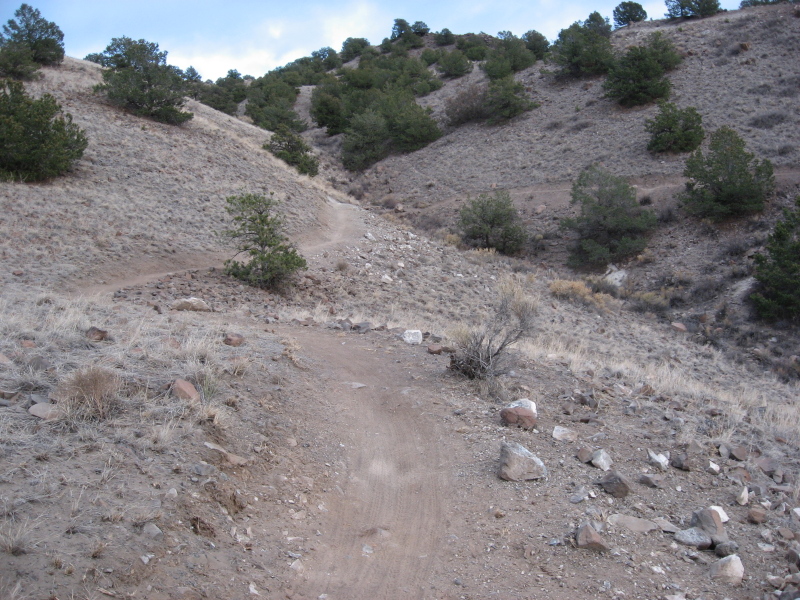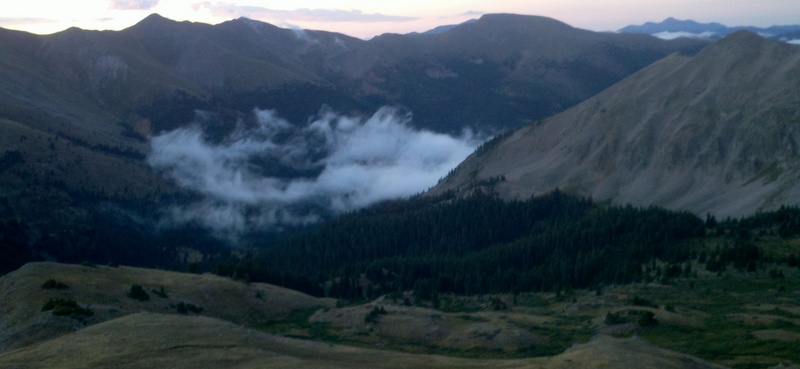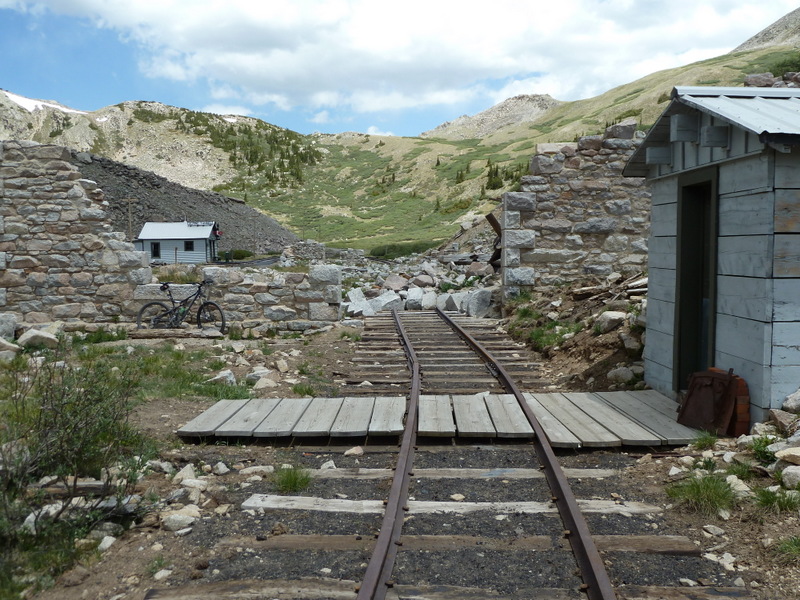
It's been several days since I left the
Durango Dirty Century course; cold, wet, and emotionally rattled. I've been trying to sort out my memories and feelings about it since then. It was an intense, personal experience. I'm going to relate the story, but it will be like a picture taken of a glorious landscape--it won't do the actual experience justice.

The event official start time was 6:00 AM Saturday July 7. But some of the riders of more moderate speed like myself agreed to meet at
Velorution Cycles to start at 5 AM, hoping for a better chance of finishing at a decent hour. This ride is a big one. The fastest rider in 2011 finished in over 12 hours. That kind of difficulty and distance leaves somebody of my ability facing an 18 or more hour day.
Very light rain was falling as five of us rolled through a mostly deserted Durango, heading north toward the Hermosa Creek Trailhead. As the dawn brought light to the day, the sky was
gray overcast and the ground everywhere was moist. But it was warm enough for shorts and short sleeves.
The easy climb up Hermosa Creek was pleasant, it's a beautiful trail and normally a person has lots of company. But when you hit the trailhead around 6 AM it's pretty much deserted.

After the first aid station we jumped onto the Bolam Pass road. Everything was beautiful and green, and there were clumps of misty cloud up on the mountainsides above. The climb is mostly very aerobic, but as the top of the pass nears the road gets steeper and lumpier.

I was feeling really good. I was keeping up on my food and hydration, my legs felt good, and the temperature was perfect. The moist air was kind to the lungs. I stuck with
Matt's advice, and rode at a relaxed, recreational pace. The ride from town, up Hermosa, all the way to the pass is pretty much a prologue. As Matt explained, the real work starts after Bolam and continues to around mile 70 at Kennebec Pass. Don't burn up your legs getting up to Bolam from town, save it for what comes after Bolam.

The section of Colorado Trail that we jumped onto at the pass is absolutely stunning. It's probably the prettiest bit of Colorado Trail I have ever seen. All of the Colorado Trail that I saw during this event was remarkable. It's rugged and dramatic, and with all the moisture that's been coming to the San Juans lately the vegetation was spectacular.
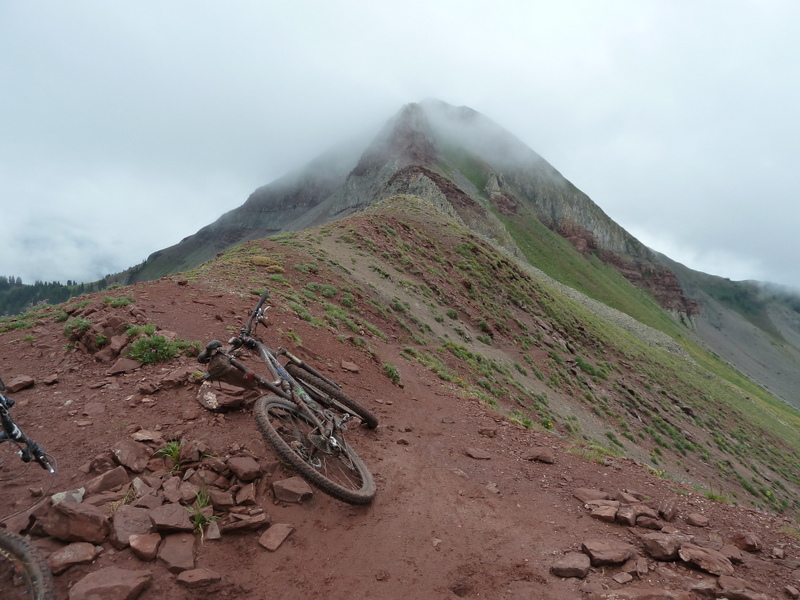
As I worked my way south, rain started falling lightly. I passed among peaks that were shrouded in cloud. As I said, it was beautiful--a dramatic landscape in muted light with vibrant flowers being fed by soft moisture.
But then the rain began to fall harder. And harder. Soon it was a full downpour. I stopped and pulled out my rain jacket. The trail filled with water, and where it went up or downhill it ran with red mud. I was mostly climbing or traversing, but then came to a point where it was time to descend through a series of switchbacks. In dry conditions I would have been able to make good time, but it was far to slippery to let myself gain any momentum.
Then I had my first crash. I was rolling along at a very moderate pace and needed to avoid a large stick in the trail. I rode up onto the left side of the trail, but the slant of the trailbed caused my front wheel to slip then wash out. I tried to stop my crash by throwing my left leg out to the side but before I knew it I was somersaulting off the bike into the muddy wet grass.
When I got back on and started descending again I noticed that my front brake lever was almost contacting the grip as I pulled it. I had put brand new pads on both front and rear days earlier in preparation. I use mechanical discs, so when the pads wear they need to be adjusted for slop manually. I wondered if my cable was slipping, but finally concluded that the pads were wearing so fast that I would need to adjust them already. The grit and mud was melting them away like butter.
Eventually the rain slacked and the trail leveled out. But the tread was so sloppy and the rocks so slick, it was difficult to ride. I wound up walking way more than I should have needed to. Several riders caught up to me at this point. It was discouraging. I was concerned about the toll this was taking on my bike. I was about halfway in miles, and had only started
the hard part.
The picture above is from Blackhawk Pass. I crashed 4 or 5 times descending off that pass. The rain had stopped but the trail was pure grease. They weren't bad crashes, just slow rolls. But they rattled me. I could hardly go slow enough to keep from washing out the front tire.
Soon the second aid station appeared. It was such an incredible shot in the arm. There was plenty of water that could be used to wash down the bike, getting some of the mud out of the chain, derailleurs, and brakes. And the rain had stopped. And they had some great food. Including bacon! And of course, great people. Lots of smiles and friendly encouragement. The volunteers for this event deserve some real credit; they were wonderful.
So maybe that was it for the weather, perhaps the day was going to become moderately dry from here on out. Sure seemed like it was clearing out and getting nice.

The sun actually came out as I road south away from the second aid station. My bike slowly dried off, and eventually it was dry enough that I could re-apply chain lube. I scraped drying mud off the derailleur jockey wheels.
I adjusted my brakes one more time. I started riding and it was actually feeling like a normal bike. We had survived the deluge.
But there were some hard miles ahead. I was feeling the strain of the day. But I kept drinking and putting food in my mouth, and I had taken in some good calories at the aid station.
As I approached a section called the Highline Trail, there was some tough climbing. It wouldn't have been bad if I hadn't been so hammered. But for me, at that time, it was hard. I took Matt's advice again, don't stop. Keep moving. I would pedal granny gear until I started to see stars, then jump off and immediately start pushing. No standing around trying to catch my breath, I caught my breath as I was walking. And then watched for relatively level spots to get back on and start pedaling again.
As I worked on this long steady climbing section, muttering thunder started getting closer. I could see a dark gray cloud ahead. I could not see any lightning, but I could hear it. We seemed to be on a collision path. But there was nothing for me to do but keep marching. If the storm overtook me I would just have to wait it out. I wasn't planning to be done until after dark anyway.
It was about 4:30 PM. My GPS showed less than 1 hour of stopped time, and I was into my 11th hour of moving time. I was feeling pretty haggard, but I was resigned to stay the course, as the saying goes. On the DDC course, there aren't any easy bail points. And from where I was there was only backtracking many miles to a viable bail point. The only real choice was to move forward.
But then once again, things looked up. I arrived at something of a summit, and saw a sign that said
Highline Trail. The storm that had been seeming ready to overtake me now was clearly moving off to my right. I had missed it! I was OK. I hopped onto the bike and the trail started to flow for me. There were ups and downs, but it became a flowing, rideable trail. I was moving again! I was actually covering miles!
Things looked good for me at that point. I saw that I was moving into the upper 60s in miles traveled. Matt had said that the hardest stuff was up to about mile 70. So perhaps I was on the verge of arriving at Kennebec Pass and the final aid station! It was around 5, and I had heard somebody say at the last aid station that anybody who got to Kennebec after 5:30 would be finishing in the dark. Well I had planned to finish in the dark. If I arrived at 5:30 maybe I would be there sooner than nightfall!
Then I got to a sign post. The sign read,
Kennebec Pass, 5 miles. Ouch. A bit further along was another sign that said
Kennebec Pass Road, 6 miles. My GPS said 68 miles. So, Kennebec would be at roughly 73, and the road at roughly 74? Where would the aid station be, the pass or the road? I assumed the road.
But would it even be there by this late? I had been told not to expect aid stations to be running past a certain point. They would not wait for every rider.
And then the trail turned sharply upward. Ouch again.
I ran into a fellow rider. Robin from Fort Collins was stopped for a rest and saw me hike-a-biking up the trail. We talked about bike polo. He was wearing an Oskar Blues jersey and riding a Dean belt-drive singlespeed. Robin and I made our way onto a segment that I see on the topo maps labeled as Indian Ridge.
It was dramatic, but it lead to a series of hard, rugged hike-a-bikes up over 12K + summits. Eventually I lost site of Robin.

Time was passing. 5:30 was
long gone as I chugged my way up and over these tough hills. The miles ticked by
very slowly. But I held to my conviction to keep moving. Keep marching. Ride when possible, push when riding was not possible. But keep moving.
I eventually made an exception to that rule because I started getting the unmistakable feeling that it was time for another influx of calories. I pulled off my pack, sat down, and began stuffing food into my mouth and chewing it and swallowing it. I was stopped for less than 5 minutes according to my GPS. It was now saying that my total stopped time for the day was about an hour and 10 minutes. Moving time was in the neighborhood of 13 hours. Miles traveled over 70.

I approached one of the summits, and it was shrouded in cloud. It was beautiful. Awesome. I was exhausted and nervous, but inspired. I was in such an overwhelmingly dramatic place. I trudged up into the cloud, and immediately realized that it wasn't just mist. It was rain. I marched on into the soft rain, and my nervousness ticked upward a notch.
Then the rain got harder. My rain jacket had been stowed back into the pack after the last storm ended. Time to get it back out. I stopped for as short a time as possible to haul it out and put it on. I was feeling a bit of anger. Most of it was directed at myself for being so slow that I was going to be caught in another shower. And I was annoyed that the best part of this ride was to be the long singletrack descent back to the western terminus of the Colorado Trail. And now, would it be a river of mud like I'd experienced in the morning? Crashing? Brake pads worn down to a point of worthlessness? Walking the descent because of failed brakes?
Then the sleet started and the rain came down harder. I crested a summit, only to see that there was another beyond it. I felt a wave of exhausted frustration. I tried to mount my bike to descend off the summit, but the rocks were too slippery with mud and sleet. I had to walk down. I muttered and stumbled toward another summit.
I staggered my way up through loose rock onto the next ascent trying to increase my pace. The rain and sleet came down hard and as I left the rock and got into low willows, and the trail again ran with mud.
Then came the first flash of lightning. I instinctively started counting immediately.
I did not get to count to two. The clap of thunder was severe. It was close. It was on me.
With a strong sense of anger and frustration, I dropped my bike and crouched down in a gap between the willows. Time to hunker down and wait for the electricity to pass. I could see the slope curving to the rounded summit above me--I was right near the top.
Another violent flash and almost simultaneous boom made me jump. I went from crouch to sitting right on the ground to get lower. I hunched over. The icy cold wetness of the ground came up through my lycra shorts. I knew immediately that the rain jacket alone wasn't going to cut it. I needed to put on my rain pants. I pulled them out of my soaked backpack, but was hesitant to stand up enough to get them on. I pulled them on awkwardly then immediately sat back down. I also pulled a lycra beanie out of the pack, yanked it onto my head and pulled the rain jacket hood on over it. I faced down watching the sleet piling up on my feet and legs.
Time started passing. The lightning and hard sleet and rain continued consistently.
Emotions and thoughts flashed through my head; I was irritated with my luck. I was irritated that I hadn't been fast enough. I regretted having stopped to spend 5 minutes eating. But with every flash of lightning my anger and frustration was chopped away and replaced by fear and shame.
I was overwhelmed with a profound regret at my own hubris. I congratulate myself that I know what it takes to be in the high country. I bring rain gear. I have extra warm things that I can put on... but I only had one pair of gloves, and they were soaked. I had a thick base layer still in the pack, but would it be enough, even nearly enough? I didn't want to try to put it on at that point because I'd have to take off my rain jacket...
Was the aid station gone? Was I going to have to find my way down through 25 miles of wet chill and mud to get back to safety and shelter? I knew there was one more significant climb after Kennebec. Would I be able to handle it? How much water did I even have left?
When would the core of this storm move off?!? How long had it been already, half an hour? I started to shiver. It dawned on me then that I might get hypothermia before the lightning ever moved off allowing my to safely climb down off this summit.
It's hard for me to admit to how deep my fear ran. I will admit to wailing out a few loud sobs. I was becoming more frightened with every passing minute. The possibility that this could be the last day of my life began to feel very real. I could get hit by lightning even as I sat here bent over in the mud. I could get so cold that even when the storm did relent, I would be unable to think clearly, move, get myself out. And even if I did get down off this crazy place, I was miles and miles and
miles from being safe.
I decided I had to move. I jumped up, still staying as low as possible and pulled on my sopping wet pack. I picked up my bike and ran next to it with my head low. The summit truly was right there. I had been sitting only about 100 feet from the top. I crested it as lightning continued to flash and thunder roared. I ran off the other side of the peak and saw a basin cirque below with a lake. The trail down was steep and rutted and rocky. It ran with a river of mud. I slipped and scrambled down until it looked like I could safely ride then I jumped on and rolled through a running river on the trail. The lightening was every bit as close as it had been when I was on top. Thunder came immediately after every flash. My outbreaths produced panic noises. Once again I could feel my brakes squish down--the pads were melting away ridiculously fast even as I descended only a moderate slope.
I came to an intersection and had to wipe the mud and water from my GPS screen to confirm that I was taking the correct branch. Going the wrong way now could be a lethal mistake.
Eventually I heard the thunder recede behind me, but the rain continued to hammer down.
I came over a slight rise, and saw an easy-up with 5 people standing under it. The aid station was still there! Relief washed over me. I felt so grateful, so lucky, that help was there.
My ride ended there. Two aid station volunteers and three other riders were waiting there. They had been anxiously watching for me. I was very, very close to showing them all some real tears of relief and fear.
I was shivering badly even now out of the rain. I reached into my pack for the last remaining piece of clothing I could put on, a Patagonia Capilene 3 mid-layer. It was soaked. Totally soaked. If I had needed to rely on it I would have been sorely disappointed.
It was obvious that none of us was going to attempt to finish. All we wanted to do was figure out how to get down. Get back to civilization.
An acquaintance of one the volunteers was just driving by in an old Toyota Land Cruiser. We waved him down. He offered to take people and bikes down. The aid station guys just had a little 80s Toyota truck. We had been considering stashing the bikes in the bushes and putting the four of us in under the shell to drive down. The Land Cruiser took four people and two bikes, the other two bikes went into the truck and we headed down.
The rest of the story is interesting, but this is already a long story... Suffice to say that it took a full hour of 4-wheeling to get down to Hesperus, 20 minutes west of Durango. From there friends were called to pick us up and give us rides back to town. The aid station volunteers turned around to go back up to Kennebec to break down the aid station. I gave them $20 and told them that there wasn't any amount of money that could express my gratitude.
It was 10 PM when I got dropped off at my motel where I could peel off my wet muddy clothes and get a warm shower. And go to bed. I didn't really sleep though--my nerves were too jangled and my body too thrashed.

Colorado has gone from scary dry to wet as Seattle in November. Last night, the third rain storm of the day came hammering down on Salida. I took this picture out my kitchen window. I stood there in my kitchen, safe and dry, and watched nature do what she would. I felt a rush of memory of those long minutes on the summit, and an appreciation for how fragile we are. Or at least how fragile I am.
I love those mountains. I have always been in awe of their power, beauty, and stark indifference to our safety and comfort. But this past Saturday I had my illusions of preparedness and control stripped away. When we go up there, we can be prepared. But can we be prepared for
anything and everything those mountains might throw at us?
I learned a great deal on Saturday. It was a very rich day for me. I lived through a crazy dangerous situation, I saw achingly beautiful landscapes, the people around me vastly exceeded any reasonable expectations I might have for their capacity to watch out for each other (for me specifically). And I learned about being prepared. I'll be better prepared next time, but I won't fool myself into thinking that I've got any guarantee that it will be enough to keep me safe in any situation.






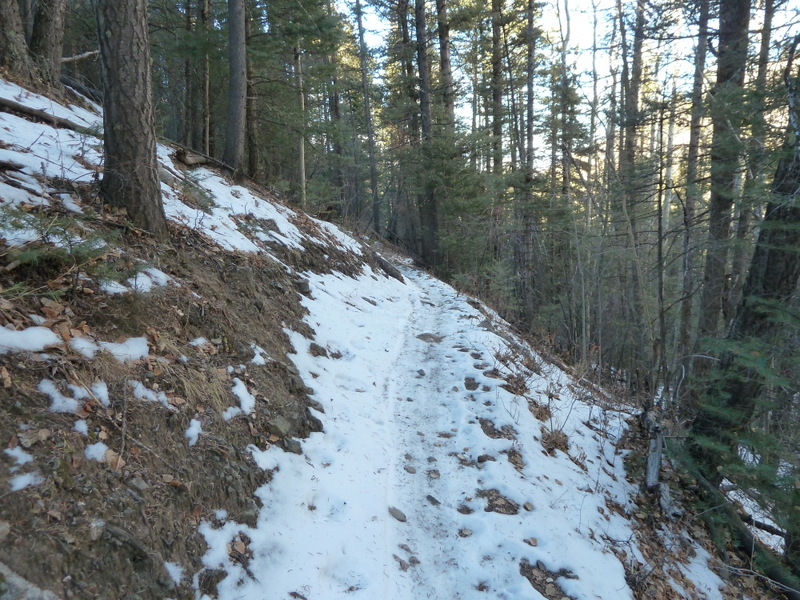
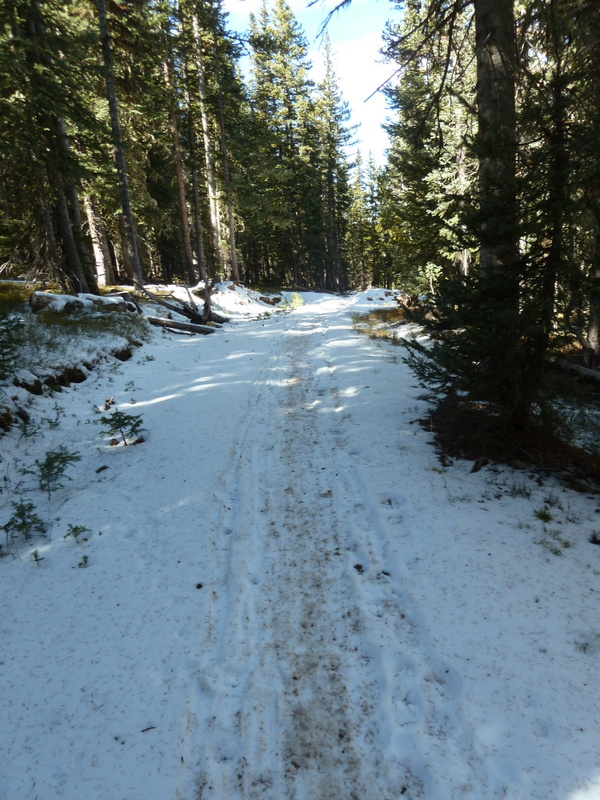




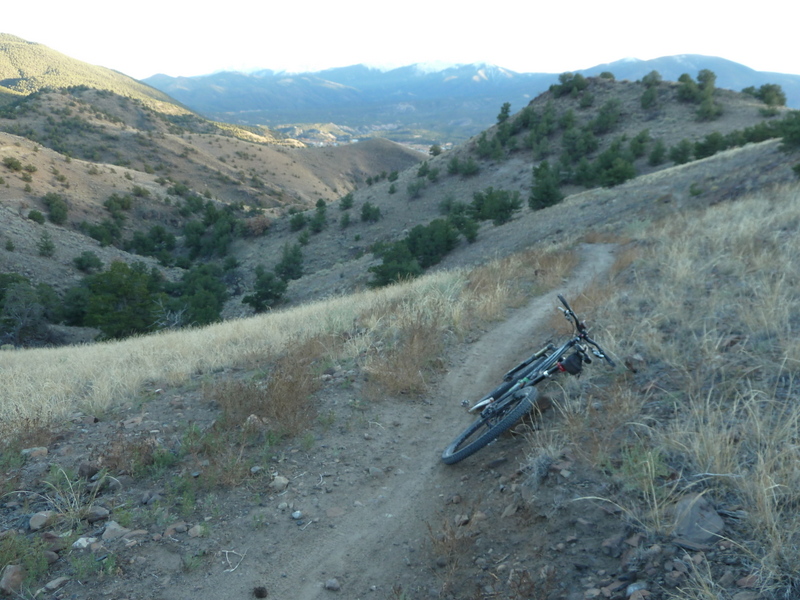

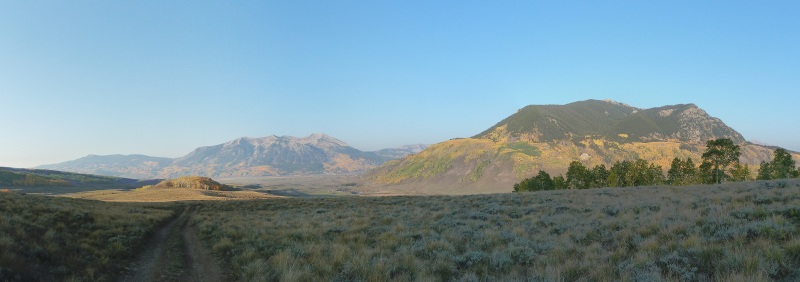





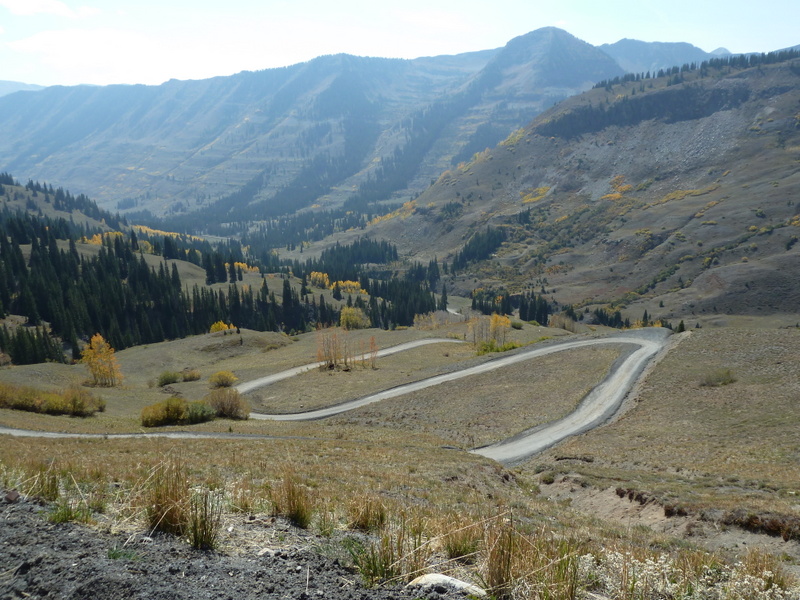

 Another shot from 401.
Another shot from 401.
